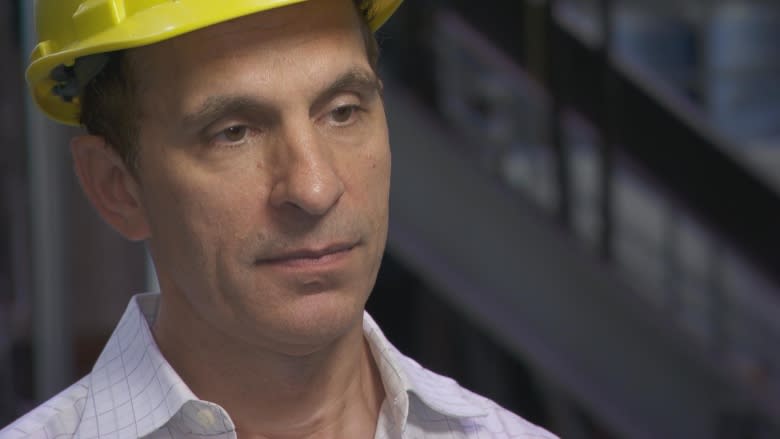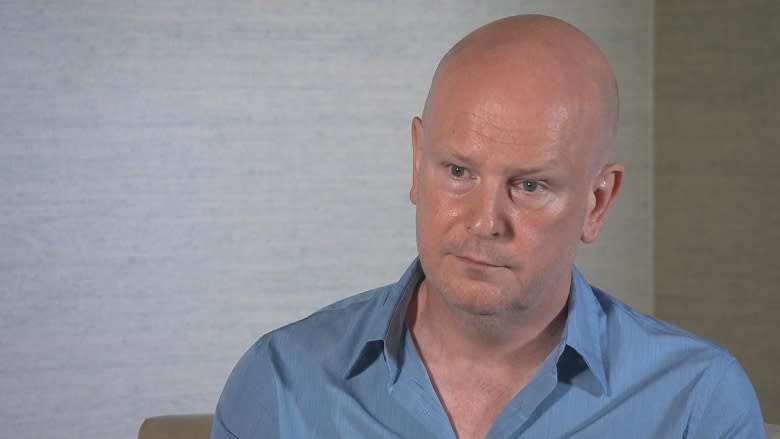'Inexcusable' mistakes: Radiohead still wants answers 6 years after fatal stage collapse in Toronto
Radiohead drummer Philip Selway is calling the mistakes outlined in a report into the fatal 2012 Toronto stage collapse that killed the band's drum technician "inexcusable."
The British rock band returns to the city tonight for the first time since the collapse in Downsview that took the life of Scott Johnson, 33.
"As a band, we're very aware of what it will cost the crew being there emotionally," Selway said.
"It's six years now, it's six years without answers. Without answers to what went wrong, there's nothing that you can put in place to prevent it from happening again."
Despite a year-long investigation by the Ontario Ministry of Labour into the collapse, and 13 charges being laid, the courts failed to provide answers. After two trials, all charges were stayed because the matter had taken too long to go through the courts, bitterly disappointing the band and Johnson's parents, Sue and Ken.
Since then, CBC has obtained an Ontario Ministry of Labour incident report under freedom of information legislation that helped form the basis of the Crown's case against Live Nation, Optex Staging and Domenic Cugliari. According to the report, he was the engineer who "signed and sealed the stage drawings and provided the final stage report."
The report, a summary of a much larger engineering report prepared by provincial engineers after the collapse, outlines numerous issues with the design and execution of the structure that was to suspend more than 27,000 kilograms of equipment in the air.
Selected findings of the ministry report include:
- The overall weight of the suspended roof grid system was miscalculated.
- The construction did not follow the design.
- Devices used to weigh stage components were insufficient.
- Sixteen ballasts not installed correctly; three were not connected to any stage component.
- No locking pins were installed in some upper sections of the scaffolding system.
The report pinpoints the primary cause of the collapse as "crushing to the pick-up trusses" — the metal structures that were supposed to hold the stage roof structure and lighting in the air.
"Those deviations cost Scott's life," said Selway. "And so yes, that makes me angry. And until that's actually acknowledged in a wider sense, that's going to happen again.
"I mean, I'm sure there's always a margin of error in any working practice, isn't there? But that's a lot of errors to have, and that can't and shouldn't happen again," Selway said.
"Those kind of mistakes, they feel inexcusable."
CBC also shared the report with University of Toronto forensic engineer Doug Perovic, who was part of a team of engineers who originally investigated the collapse.
He zeroed in on what he believes to be at the root of the collapse: a set of trusses not in the design and not able to withstand the weight of the stage grid gave way.
"They were interchanged from what was in the design drawings," Perovic said. "It's as simple as that."
In a statement to CBC, lawyers for Cugliari said: "The pick-up trusses installed by Optex Staging at Downsview were not designed or approved by Mr. Cugliari and Mr. Cugliari was not informed by Optex Staging that they were not using the original pick-up trusses designed for the Optex Stage."
But if the structure failed to follow plans, who should have caught it?
"That should have been caught firstly by the design engineer who is responsible for making sure there are no discrepancies or significant deviations from the design drawings. And then secondly the constructor who's building this," said Perovic.
However, an engineer has a specific duty to the public, according to Perovic.
"He designs the structures. Signs off on it. Then he has to actually show up when this is being constructed and see that the construction is as per his designs so that there aren't significant deficiencies or errors."
Unless it was not specifically part of the scope of his work, Perovic said, "the engineer is responsible."
The Optex stage had been around for decades and Optex had erected this stage in multiple locations over the years.
Cugliari's Toronto-based lawyers say that their client was not retained to review the original components of the Optex stage but to review specific components of the stage for the Radiohead show.
They say Cugliari did not design or approve the trusses that failed in the collapse and they say there were no design failures associated with the components he was retained to review.
"If Optex Staging had installed the original pick-up trusses that were designed for the stage being erected at Downsview, then the stage would not have collapsed."
The lawyers say if Cugliari had been made aware of the pick-up trusses that were being used, he would not have approved it.
This isn't the first time Cugliari's name has been associated with a fatal collapse. On Nov. 14, 2000, a scaffold suspended over the side of the Ambassador Bridge in Windsor broke apart. Painter Jamie Barker, 28, plummeted roughly 50 metres to his death in the river below.
Cugliari and another engineer were charged under the Occupational Health and Safety Act for "giving negligent or incompetent advice and/or certification on the design of a suspended scaffolding that endangered the lives of workers," but the charges were withdrawn by the Crown in 2003 because conviction was unlikely after a second engineering report was at odds with the original report.
A subsequent inquest into Barker's death made several recommendations targeting Professional Engineers Ontario (PEO), the professional body that oversees engineers in the province.
Cleared of professional allegations
Among them, PEO was asked to review the "ethical and professional conduct" of the engineers involved in the case. Cugliari was cleared of allegations of misconduct by the professional body, but the engineer he worked with was sanctioned.
A PEO investigation into Cugliari's role in the Downsview collapse is ongoing. The organization said it can't comment on or confirm the details of any investigation. It said it looks for ways to improve its "transparency, accountability and effectiveness in regulating professional engineering."
Cugliari has recently retired, but retains his P.Eng. certification.
In an email statement to CBC, Cugliari's legal team said: "It is always distressing when workers are injured or lose their life on a project and questions arise over whether the professional engineer is responsible."
The statement notes Cugliari expressed "his sympathy and condolences for the families and friends of those who have been injured or lost their lives."
Norbert Becker, a Windsor-based engineer with 50 years of experience, has twice reviewed fatal collapses associated with Cugliari: the Ambassador Bridge and the Downsview incident.
"On the one extreme, it seems extremely unlucky," Becker said. "If you look at us [engineers] as drivers, how many of us have more than one accident in a period of time? That may mean that they're not as competent a driver as they should be or it may just mean they drive a lot and 'I've had bad luck.' So one can't really draw any inference."
'Take a more active role'
He firmly believes PEO needs to do more to help the profession learn from tragedies in which engineers have some involvement.
"I think they should be more proactive and be looking at serious accidents," Becker said. He wants PEO to take a more active role investigating incidents and providing guidelines to prevent others from happening.
Perovic believes the lack of answers in the Downsview collapse is also something of a professional black eye.
"It's actually embarrassing for this province that a tragedy like this sort of went this many years without a lesson that's yet to be learned," Perovic said.
Despite the assertions of engineers and the findings of the report, Dale Martin, Optex Staging's head, doesn't agree. He told CBC the stage did not fail because the wrong pick-up trusses were installed.
He also said it was his expectation that the engineer would ultimately ensure the structure was safe although he said that his longstanding working relationship with Cugliari was largely verbal. Martin said the Downsview stage structure doesn't exist anymore.
Live Nation did not respond to CBC's request for comment. The tragedy prompted Radiohead to cut ties with the world's biggest concert promoter, at least for now.
"Not as a boycott per se, but we've said we can't work with you until this is resolved," said Adrian Bullock, the band's tour accountant.
"In fairness, we've started talking to them again, if only to try and explain why we feel as we feel. And they say we understand why you feel as you feel, but ultimately [they're] still platitudes, ultimately we want to find out what happened -- that's it."
'You cannot put a price on safety'
Leaving nothing to chance, Radiohead has also hired its own engineer since the 2012 collapse.
"It makes it an additional expense ... and it's more hassle, but you cannot put a price on safety," said Bullock.
In December, the office of Ontario's chief coroner announced that there would be an inquest into the collapse, but a date has not yet been set.
Selway hopes an inquest is the one process that won't fail them and will provide answers.
"I think for all of us … really what we've wanted from the get-go on this is just an understanding of what happened, why it happened and kind of to respect Scott's memory, how we can prevent that happening again."
Read the full Ontario Ministry of Labour report into the 2012 stage collapse at Toronto's Downsview Park:




